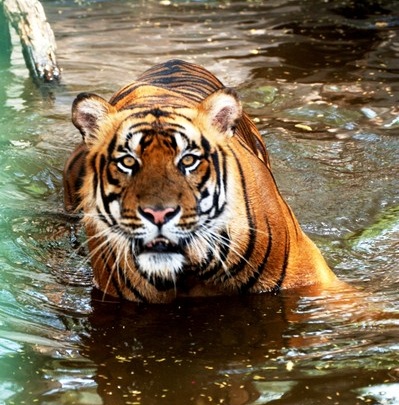Tigers have a reddish-orange coat with vertical black stripes along the flanks and shoulders that vary in size, length, and spacing. Some subspecies have paler fur and some are almost fully white with either black or dark brown stripes along the flanks and shoulders. The underside of the limbs and belly, chest, throat, and muzzle are white or light. White is found above the eyes and extends to the cheeks. A white spot is present on the back of each ear. The dark lines about the eyes tend to be symmetrical, but the marks on each side of the face are often asymmetrical. The tail is reddish-orange and ringed with several dark bands.

Tigers are powerful animals, one is known to have dragged a gaur bull weighing 700 kg. Tigers have short, thick necks, broad shoulders, and massive forelimbs, ideal for grappling with prey while holding on with long retractible claws and broad forepaws. A tiger’s tongue is covered with hard papillae, to scrape flesh off the bones of prey.
References
Mazak, V. 1981. Mammalian Species. Panthera tigris, 152: 1-8.
Ullasa, K. 2001. The Way of the Tiger. Stillwater, MN: Voyageur Press.
Sunquist, M., F. Sunquist. 2002. Wild Cats of the World. Chicago: University of Chicago Press.
Thapar, V. 2005. Wild Tigers of Ranthambhore. New Delhi, NY: Oxford University Press.















… [Trackback]
[…] Find More on to that Topic: natureinfo.com.bd/panthera-tigris/ […]